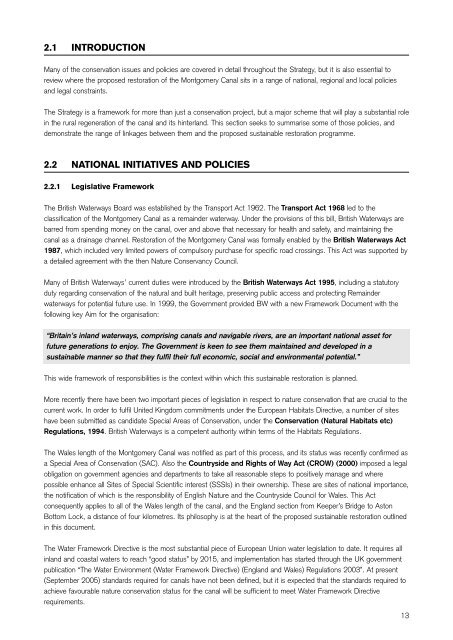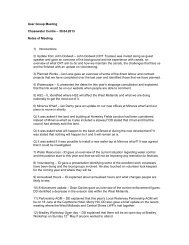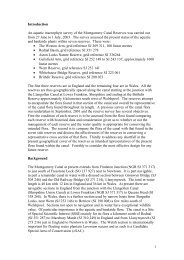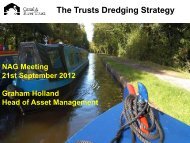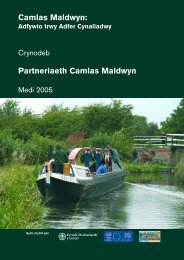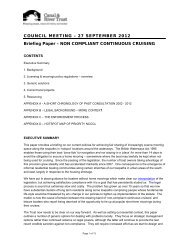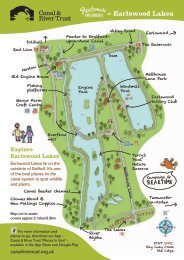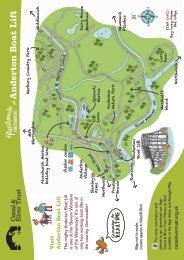Montgomery Canal Conservation Management Strategy (1.2MB PDF)
Montgomery Canal Conservation Management Strategy (1.2MB PDF)
Montgomery Canal Conservation Management Strategy (1.2MB PDF)
You also want an ePaper? Increase the reach of your titles
YUMPU automatically turns print PDFs into web optimized ePapers that Google loves.
2.1 INTRODUCTION<br />
Many of the conservation issues and policies are covered in detail throughout the <strong>Strategy</strong>, but it is also essential to<br />
review where the proposed restoration of the <strong>Montgomery</strong> <strong>Canal</strong> sits in a range of national, regional and local policies<br />
and legal constraints.<br />
The <strong>Strategy</strong> is a framework for more than just a conservation project, but a major scheme that will play a substantial role<br />
in the rural regeneration of the canal and its hinterland. This section seeks to summarise some of those policies, and<br />
demonstrate the range of linkages between them and the proposed sustainable restoration programme.<br />
2.2 NATIONAL INITIATIVES AND POLICIES<br />
2.2.1 Legislative Framework<br />
The British Waterways Board was established by the Transport Act 1962. The Transport Act 1968 led to the<br />
classification of the <strong>Montgomery</strong> <strong>Canal</strong> as a remainder waterway. Under the provisions of this bill, British Waterways are<br />
barred from spending money on the canal, over and above that necessary for health and safety, and maintaining the<br />
canal as a drainage channel. Restoration of the <strong>Montgomery</strong> <strong>Canal</strong> was formally enabled by the British Waterways Act<br />
1987, which included very limited powers of compulsory purchase for specific road crossings. This Act was supported by<br />
a detailed agreement with the then Nature Conservancy Council.<br />
Many of British Waterways’ current duties were introduced by the British Waterways Act 1995, including a statutory<br />
duty regarding conservation of the natural and built heritage, preserving public access and protecting Remainder<br />
waterways for potential future use. In 1999, the Government provided BW with a new Framework Document with the<br />
following key Aim for the organisation:<br />
“Britain’s inland waterways, comprising canals and navigable rivers, are an important national asset for<br />
future generations to enjoy. The Government is keen to see them maintained and developed in a<br />
sustainable manner so that they fulfil their full economic, social and environmental potential.”<br />
This wide framework of responsibilities is the context within which this sustainable restoration is planned.<br />
More recently there have been two important pieces of legislation in respect to nature conservation that are crucial to the<br />
current work. In order to fulfil United Kingdom commitments under the European Habitats Directive, a number of sites<br />
have been submitted as candidate Special Areas of <strong>Conservation</strong>, under the <strong>Conservation</strong> (Natural Habitats etc)<br />
Regulations, 1994. British Waterways is a competent authority within terms of the Habitats Regulations.<br />
The Wales length of the <strong>Montgomery</strong> <strong>Canal</strong> was notified as part of this process, and its status was recently confirmed as<br />
a Special Area of <strong>Conservation</strong> (SAC). Also the Countryside and Rights of Way Act (CROW) (2000) imposed a legal<br />
obligation on government agencies and departments to take all reasonable steps to positively manage and where<br />
possible enhance all Sites of Special Scientific interest (SSSIs) in their ownership. These are sites of national importance,<br />
the notification of which is the responsibility of English Nature and the Countryside Council for Wales. This Act<br />
consequently applies to all of the Wales length of the canal, and the England section from Keeper’s Bridge to Aston<br />
Bottom Lock, a distance of four kilometres. Its philosophy is at the heart of the proposed sustainable restoration outlined<br />
in this document.<br />
The Water Framework Directive is the most substantial piece of European Union water legislation to date. It requires all<br />
inland and coastal waters to reach “good status” by 2015, and implementation has started through the UK government<br />
publication “The Water Environment (Water Framework Directive) (England and Wales) Regulations 2003”. At present<br />
(September 2005) standards required for canals have not been defined, but it is expected that the standards required to<br />
achieve favourable nature conservation status for the canal will be sufficient to meet Water Framework Directive<br />
requirements.<br />
13


